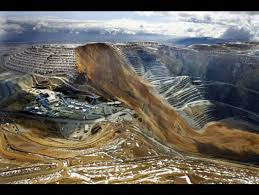Valentine’s Day is associated with chocolate and jewelry, two industries that may seem benign, but which rely on unsustainable business practices.
Here we will focus on gold mining, a filthy, toxic business. There are basically two markets for gold – jewelry, which is about 90% of the market, and bullion.
To make one gold ring produces at least 20 tons of mine waste, says Earthworks, a nonprofit that’s working to clean up the mining industry.
Globally, jewelry demand accounts for about 43% of all of mine production, they say, and gold is the worst, releasing the most toxic heavy metals like mercury and arsenic. Even after a mine is closed it often pollutes the water forever, costing billions of dollars to treat.
And the industry is known for human rights violations such as child labor and forcing whole communities from their homes.
Last year, there was a landslide at the world’s biggest open pit mine, which happens to be in Utah – it was so big that it caused an earthquake. Bingham Canyon mine is visible from outer space.

Since the industry hasn’t been jumping to the task of cleaning up its act, Earthworks has been asking jewelry retailers to clean it up from their end.
Earthworks’ Golden Rules for the mining industry:
- respect human rights and workers’ rights;
- get free and informed consent from local communities before mining;
- stay out of protected natural areas;
- stop dumping mine waste in rivers, streams and coastal waters;
- stop contaminating water, soil and air with sulfuric acid drainage and other toxic chemicals
- provide guaranteed payment that covers the costs of closing and cleaning up mines.
- Allow independent verification of the above
Retailers Sign Pledge
Over the past few years, about 100 retailers have pledged to abide by these Golden Rules, representing about 22% of the jewelry market.
"By signing the Golden Rules, retailers are making an
in-principle commitment to supporting cleaner mining and corporate social responsibility, but just as importantly, they are sending a clear signal to the mining industry that there’s a demand for more responsible gold – and that it’s time for mining
companies to clean up their act, says Payal Sampat of EarthWorks.
This year, Earthworks surveyed them to find out if they have gone beyond signing the pledge to changing their sourcing practices.
Overall, small jewelry firms have done more than the big ones, partially because they are more nimble and buy less gold.
Four received an A rating: San Francisco-based Brilliant Earth, London’s Cred Jewellry, Lena Marie Chelle Designs, and Real Jewels.
Among the big companies, Tiffany, college ring retailer Herff Jones, and Canada-based Birks & Mayors reported the most progress on using recycled metals or improving sourcing practices.
"Tiffany & Co. has been conspicuous in its leadership by
speaking out against dirty mining as well as their leadership in trying to build independent, third party certification for mining," says Sampat.
They rated retailers on:
- whether they have traced their supply chain (which isn’t easy to do);
- incorporated the Golden Rules into their policies and contracts;
- notified suppliers of their Golden Rules commitment;
- support third party certification initiatives;
- support protection of Bristol Bay, where an enormous proposed mine puts the pristine area in terrible danger
Laggards include Macy’s and Costco – which have yet to even sign the pledge – and TJ Maxx, and Harry Winston.
Referring to the Bristol Bay mine, Michael Kowalski, CEO of Tiffany & Co. says: "It is time for the voice of America’s jewelers to be heard. We recognize our businesses depend upon a healthy mining industry for the precious materials we use, but we also know there are certain magnificent places where mines should never be built. Bristol Bay is one such place … American jewelers should join now with Alaskan natives, commercial and sport fishers, elected officials, and concerned citizens in speaking out against this mine’s development," he told JCK. Kowalski says Tiffany will take out ads that urge the EPA to block the mine’s construction.
Gold mining facts from Earthworks:
- The average large gold mine uses over 1,900 tons of cyanide a year. A rice grain-sized dose of cyanide can be fatal to humans and even smaller amounts can be fatal to fish.
-
as of 2012, metal mining ranks as the top toxic polluter in the US, responsible for 40% of all reported toxic releases
-
Open-pit gold mines obliterate the landscape, opening up vast craters and flattening mountaintops.
-
Gold mining companies are extreme consumers of water and fossil fuels. One gold mine uses the same amount of water as a large US city for a year.
-
About 25% of mines globally are in or near protected natural areas.
Efforts are underway on third party certification systems for large mines and small-scale mines.
Here’s the report, "Tarnished Gold":
